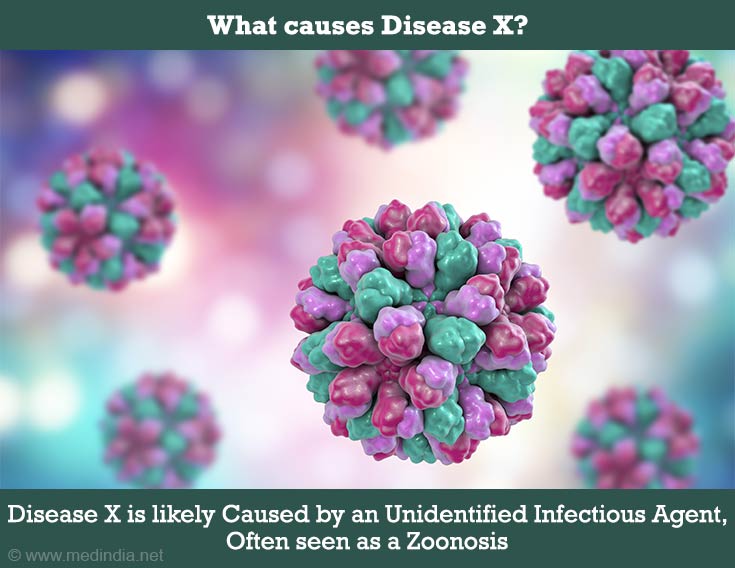- Preparing for Disease X - (https://www.weforum.org/events/world-economic-forum-annual-meeting-2024/sessions/preparing-for-a-disease-x/)
- Disease X: A hidden but inevitable creeping danger - (https://www.ncbi.nlm.nih.gov/pmc/articles/PMC8367867/)
About
Disease X is not a specific ailment but a term coined to represent a potential novel infectious agent that could pose a serious threat to global health in the future. It serves as a reminder of the vast reservoir of viruses circulating among wildlife, which could give rise to a new infectious disease for which humans lack immunity. In 2018, the World Health Organization (WHO) acknowledged Disease X by including it in a list of priority pathogens for research, emphasizing the need to prepare for a disease without existing vaccines or treatments.
Did You Know?
Disease X could be 20 times deadlier than COVID-19, urging us to prioritize global health security.The Potential Impact of Disease X
The WHO has issued a stark warning, suggesting that Disease X could result in 20 times more fatalities than the COVID-19 pandemic, which claimed the lives of approximately seven million people globally. Health experts anticipate that any new pandemic could be even deadlier, potentially causing an estimated 50 million deaths worldwide. The urgency to prepare for Disease X is underscored by the unpredictability of emerging infectious diseases, as evidenced by past outbreaks such as SARS, Ebola, and the more recent COVID-19.
Identifying Disease X
Disease X is not limited to a specific pathogen but is expected to be caused by a yet unidentified infectious agent, often considered a zoonosis, likely originating from wildlife. It is anticipated to be an RNA virus, emerging in areas where a combination of risk factors facilitates sustained transmission. The possibility that recent pandemics like COVID-19 might be milder precursors to the ultimate Disease X raises concerns about the potential severity of future outbreaks(1✔ ✔Trusted Source
Preparing for Disease X
Go to source).

Challenges Faced by Global Health Organizations
The WHO has faced criticism for its response to previous pandemics, with accusations of underreacting and limitations due to funding constraints and political influence. The organization's ability to enact timely and robust measures to curb the spread of transmissible diseases has been questioned. Lessons from past outbreaks, such as the 2014 Ebola pandemic, highlight the need for improved cooperation from governments and timely funding to effectively combat emerging threats.
Addressing the Risks and Preparedness
To mitigate the risks posed by Disease X, comprehensive and proactive measures are necessary:
- International Guidelines for Bioterrorism: Establishing international guidelines to control bioterrorism is crucial, as the use of pathogens like Ebola or Lassa viruses as biological agents could lead to epidemics.
- Expert Advice without Political Interference: Seeking timely advice from academics, free from political influence, is essential to make informed decisions and strategies.
- Immediate Travel Restrictions and Airport Screening: Implementing prompt travel restrictions and airport screening measures can contain the spread of the unidentified pathogen across borders.
- Collaboration Among Experts: Global collaboration among scientists, clinicians, and infectious disease experts is vital for the timely investigation, control, and elimination of Disease X.
- Widespread Testing and Contact Tracing: Effective containment strategies include widespread testing and aggressive contact tracing to identify and isolate cases promptly.
- Timely Investments in Medical Countermeasures: Accelerated development, availability, and approval of medical countermeasures such as diagnostics, vaccines, and clinical trials are essential before and during a pandemic.
- Active Surveillance of Virus Laboratories: Regular surveillance of virus laboratories is necessary to prevent potential leaks of new viruses that could contribute to Disease X(2✔ ✔Trusted Source
Disease X: A hidden but inevitable creeping danger
Go to source).
One Health Approach
A One Health approach, addressing the interconnectedness of human, animal, and environmental health, provides a comprehensive strategy to tackle the underlying issues leading to the spread of Disease X. This involves bridging institutional gaps, prioritizing risk areas and pathogens, and identifying potential risk factors for emerging and re-emerging infectious diseases.
To Know More about One Health, Click Here.
Conclusion
In the face of the ongoing threat posed by unknown infectious agents, exemplified by the concept of Disease X, global preparedness is imperative. Learning from past pandemics and implementing proactive measures, as outlined above, can help mitigate the potential impact of Disease X and future outbreaks. The collaborative efforts of governments, international organizations, and the scientific community are essential to safeguard global health and prevent the catastrophic consequences of unforeseen pandemics.









